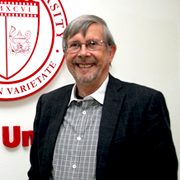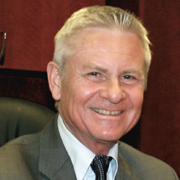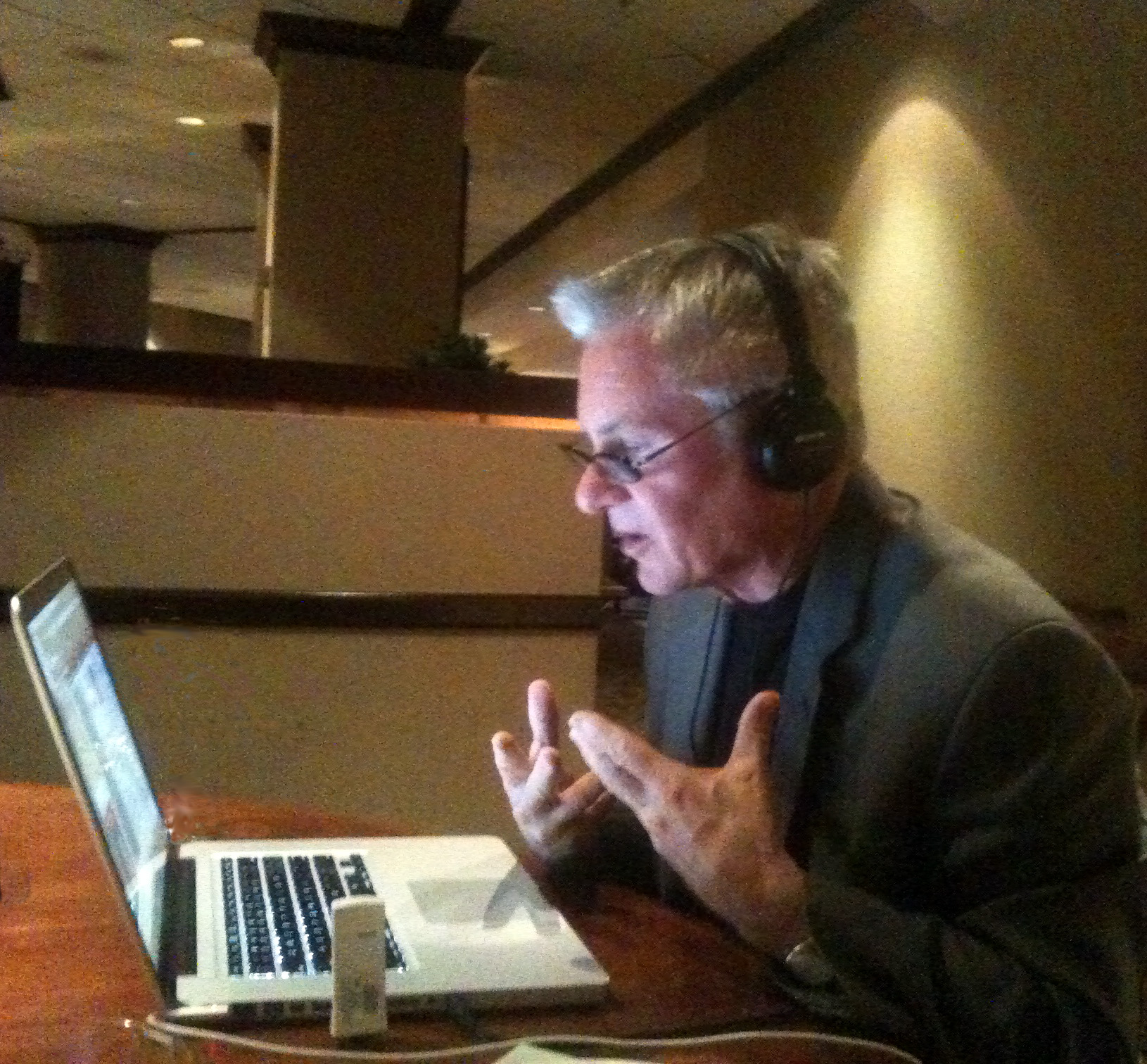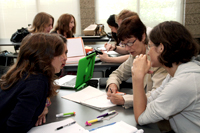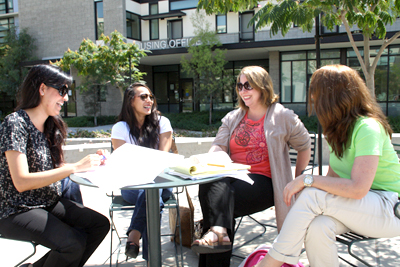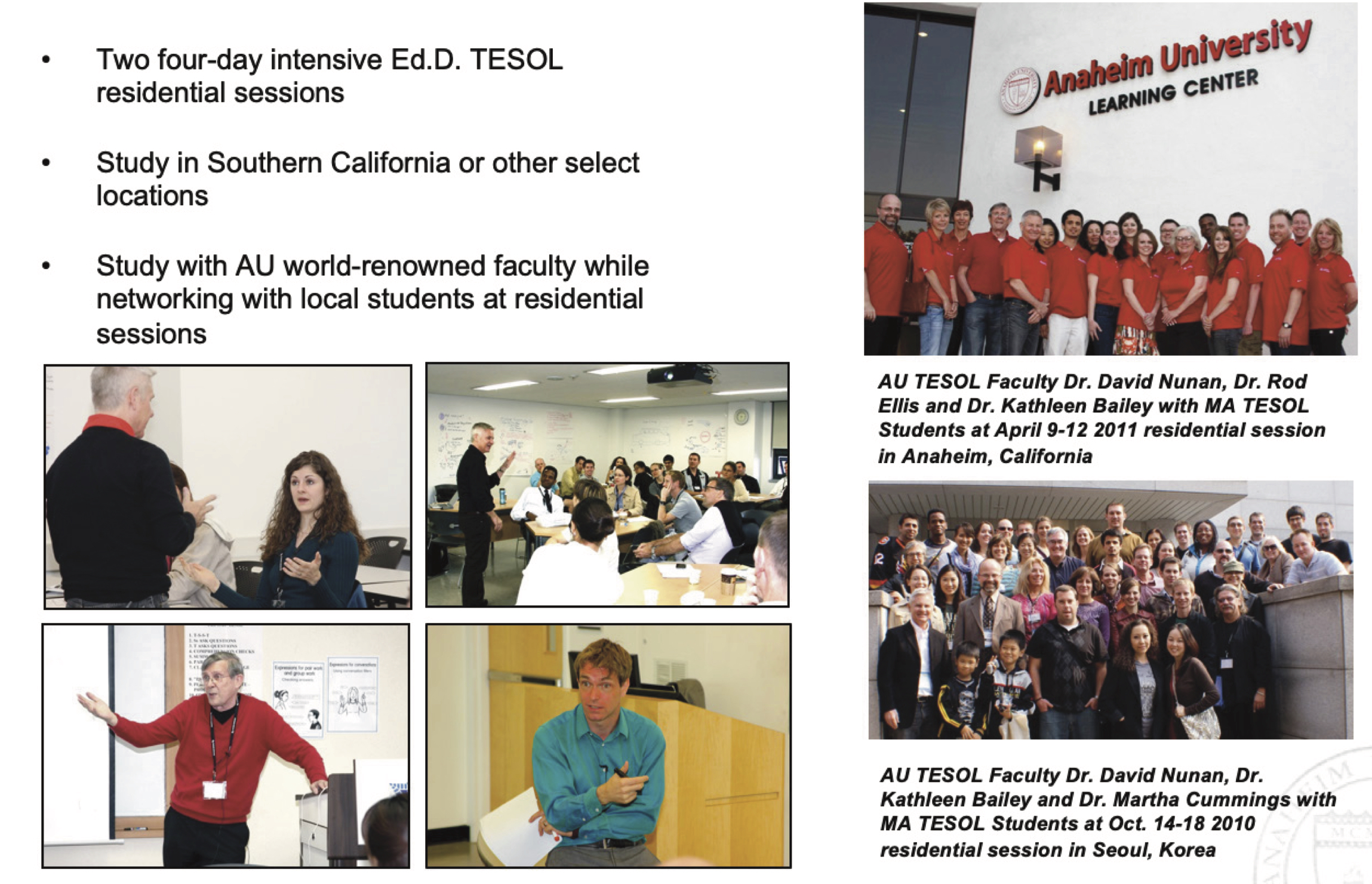
Graduate School of Education Chair of Research
TESOL Professor, Graduate School of Education
Dr. Hayo Reinders is Chair of Research and TESOL Professor for the Anaheim University Graduate School of Education. Holding a Ph.D. in Language Teaching and Learning from the University of Auckland, Dr. Reinders is also Professor of Education and Head of Department at Unitec in Auckland, New Zealand. His previous positions include Head of Learner Development at Middlesex University in London, Director of the English Language Self Access Centre at the University of Auckland in New Zealand and associate professor at RELC in Singapore. He has worked with teachers from a large number of countries worldwide and has been visiting professor in Japan, Thailand, Mexico and the Netherlands. Dr. Reinders edits the journal 'Innovation in Language Learning and Teaching' as well as a book series on ‘New Language Learning and Teaching Environments’ for Palgrave Macmillan. He is Editor of Innovation in Language Learning and Teaching, and Convenor of the AILA Research Network for CALL and the Learner. Dr. Reinders' interests are in technology in education, learner autonomy, and out-of-class learning, and he is a speaker on these subjects for the Royal Society of New Zealand. His most recent books are on teacher autonomy, teaching methodologies, and second language acquisition.
As the Graduate School of Education Chair of Research, it is my job to place our students first in everything we do. The Graduate School of Education has one of the best faculty teams in the world and together we aim to set the benchmark for online education. I look forward to sharing my passion for learning and teaching with you.
Book publications
- Reinders, H. (2023). From teacher to teacher leader. Cambridge University Press (forthcoming).
- Chong, S.W. & Reinders, H. (2023) (Eds.), Innovation in learning-oriented language assessment. Palgrave Macmillan.
- Reinders, H., Phung, L. & Pham, H. (Eds.) (2024). Innovation in language learning and teaching: The case of Vietnam and Cambodia. Palgrave Macmillan (forthcoming).
- Navarro, D., Carter, B., Roberts, N., & Reinders, H. (Eds.) (2023). Innovation in language learning and teaching: The case of the Caribbean. Palgrave Macmillan (forthcoming).
- Chong, S.W. & Reinders, H. (Eds.), (2023). Learner-Centred approaches to language assessment. Palgrave Macmillan (forthcoming).
- Jitpaissarwattana, N., Reinders, H. & Chong, SW (2023). Language MOOCs. A guide for teachers. Castledown Press (forthcoming).
- Reinders, H., Lai, C., & Sundqvist, P. (Eds.), (2022). The Routledge encyclopedia of language learning beyond the classroom. Routledge.
- Reinders, H., Coombe, C., Littlejohn, A., & Taffazoli, D. (Eds.). (2019). Innovation in language learning and teaching: The case of the Middle East and North Africa. Palgrave Macmillan.
- Reinders, H., Ryan, S., & Nakamura, S. (Eds.). (2019). Innovation in language learning and teaching: The case of Japan. Palgrave Macmillan.
- Reinders, H., Nunan, D., & Zou, B. (Eds.). (2017). Innovation in language learning and teaching: The case of China. Palgrave Macmillan.
- Reinders, H., Lewis, M., & Phung, L. (2016). Studying in English. Strategies for success in higher education. Palgrave Macmillan.
- Thomas, M., Peterson, M., Reinders, H., & Sykes, J. (Eds.). (2016). Digital language learning and teaching: Volumes I IV. Bloomsbury.
- Darasawang, P. & Reinders, H. (Eds.). (2015). Innovation in practice: Lessons from Thailand. Palgrave Macmillan.
- Reinders, H. & Lewis, M. (2014). Facilitating workshops. Palgrave Macmillan.
- Reinders, H. & Thomas, M. (Eds.). (2014). TBLT in Asia: Challenges, opportunities and future directions. Bloomsbury.
- Lewis, M. & Reinders, H. (Eds.). (2014). New ways in teaching adults. TESOL.
- Thomas, M., Reinders, H., & Warschauer, M. (Eds.). (2012). Contemporary computer-assisted language learning. Continuum.
- Reinders, H., (Ed.). (2012). Digital games in language learning and teaching. Palgrave Macmillan.
- Benson, P. & Reinders, H. (Eds.). (2011). Beyond the language classroom. The theory and practice of informal language learning and teaching. Palgrave Macmillan.
- Loewen, S. & Reinders, H. (2011). Key concepts in second language acquisition. Palgrave Macmillan.
- Thomas, M. and Reinders, H. (Eds.). (2010). Task-based language teaching and technology. Continuum.
- Reinders, H., Lewis, M., & Kirkness, A. (2010). Good teacher, better teacher. Strategies for the multicultural classroom. Perceptia Press.
- Reinders, H. (2010). The effects of task type and instructions on second language acquisition. Cambridge Scholars Publishing.
- Ellis, R., Loewen, S., Erlam, R., Philp, J., Elder, C., & Reinders, H. (2009). Implicit and explicit knowledge in a second language. Multilingual Matters.
- Reinders, H., Moore, N., & Lewis, M. (2008). The international student handbook. Palgrave Macmillan.
- L zaro, N. and Reinders, H. (2008). Independent learning centres: Tips for teachers. NCELTR.
- Lewis, M. & Reinders, H. (2007). Using student-centered methods with teacher-centered students. Pippin Publishing.
- Lamb, T. & Reinders, H. (Eds.). (2007). Learner and teacher autonomy: Concepts, realities and responses. John Benjamins.
- Lamb, T. & Reinders, H. (Eds.). (2006). Supporting independent learning: Issues and interventions . Peter Lang.
- Reinders, H., Lewis, M., & Kirkness, A. (2006). Transform your teaching. Strategies for the multicultural classroom. Pearson Education.
- Cotterall, S. & Reinders, H. (2004). Learner strategies: A guide for teachers. RELC.
- Lewis, M. & Reinders, H. (2003). Study skills for speakers of English as a second language. Palgrave Macmillan.
Articles and Book Chapters
- Reinders, H. (author), Ryan, S. (consultant), Thomas, N. (consultant), Phung, L. (consultant) (2023). The key to self-regulated learning: A systematic approach to maximising its potential. Oxford Univerity Press (forthcoming).
- Hays, J., & Reinders, H. (2023). Discontinuity, Sustainability, and Critical Learnership: Development, Dynamics, and Demand. In Handbook of research on implications of sustainable development in higher education (pp. 115-143). IGI Global.
- Gregersen, T. & Reinders, H. (2023). Teacher leadership for teacher wellbeing. In Reinders, H. (Ed.), Best practices in teacher leadership (forthcoming). Palgrave Macmillan.
- Chong, S.W., Reinders, H. (2023). Learning-Oriented Language Assessment—Insights for Evidence-Based Practices. In: S.W. Chong & H. Reinders(Eds.). Innovation in learning-oriented language assessment (pp. 1-11). Palgrave Macmillan. https://doi.org/10.1007/978-3-031-18950-0_1
- Lin, L. & Reinders, H. (2023). Development and content validation of an e-portfolio to assess and promote learner autonomy. In: S.W. Chong & H. Reinders(Eds.). Innovation in learning-oriented language assessment (pp. 311-330). Palgrave Macmillan.
- Stewart, G. & Reinders, H. (2023). Metacognition and self-awareness: The impact of one language teacher’s reflection about his instructional delivery and his personality on his self-awareness and his metacognition. Studies in Language Teacher Education, 1(1) (forthcoming).
- Reinders, H. (2022). Making sense of big (and not so big) data with language learning analytics. In: P. Watkins (Ed.), Better learning research review. Cambridge University Press, (forthcoming).
- Reinders, H. & Chong, S.W. (2022). Computer-assisted-language learning (CALL) as a pedagogical framework. In: C. Chappelle (Ed.), Encyclopaedia of applied linguistics. Wiley (forthcoming).
- Reinders, H., Dudeney, G., & Lamb, M. (2022). Using technology to motivate learners. Oxford University Press.
- Reinders, H. (2022). Teacher leadership. In: L. Liontas (Ed.), The TESOL encyclopedia of English language teaching. Wiley.
- Nakamura, S., Reinders, H. & Darasawang, P. (2022). A classroom-based study on the antecedents of epistemic curiosity in L2 learning. Journal of Psycholinguistic Research.
- Chong, S.W. & Reinders, H. (2022). Autonomy of English language learners: A scoping review of research and practice. Language Teaching Research.
- Reinders, H. & Nakamura, S. (2022). Engagement in language learning and teaching. In: S. Mercer & T. Gregersen (Eds.), The Routledge handbook of psychology of language learning (pp. 137-148). Routledge.
- Jitpaisarnwattana, N., Darasawang, P. & Reinders, H. (2022). Understanding Affordances and Limitations in a Language MOOC from an Activity Theory Perspective. Research and Practice in Technology Enhanced Learning, 17(9).
- Reinders, H., Lai, C. & Sundqvist, P. (2022). Language learning and teaching beyond the classroom. In: H. Reinders, C. Lai & P. Sundqvist (Eds.), The Routledge handbook of language teaching and learning beyond the classroom (pp. 1-6). Routledge.
- Chong, S.W., Khan, A. & Reinders, H. (2022). A Critical Review of Design Features of LMOOCs. Computer-assisted Language Learning. DOI: 10.1080/09588221.2022.2038632.
- Bonner, E., Garvey, K., Miner, M., Godin, S. & Reinders, H. (2022). Measuring real-time learner engagement in the Japanese EFL classroom. Innovation in Language Learning & Teaching. DOI: 10.1080/17501229.2021.2025379
- Nakao, N. & Reinders, H. (2022). “This is the end.” A longitudinal case study of a Japanese learner’s experience and regulation of anxiety. Education Sciences, 12(1), 25.
- Jitpaisarnwattana, N. & Reinders, H. (2022). Language MOOCs. In: L. Liontas (Ed.), The TESOL encyclopedia of English language teaching. Wiley.
- Jitpaisarnwattana, N., Darasawang, P. & Reinders, H. (2022). Delving into personalisation behaviours in a language MOOC. International Journal of Learning, 21(1): 92-109.
- Stewart, G. & Reinders, H. (2022). Teacher Cognition and Change: Implementing Active Learning in a Japanese English Language Course. Explorations in Teacher Development, 28(3), 3-20.
- Allahyar, N., Zarrinabadi, N. & Reinders, H. (2022). How teachers’ perceptions of learners’ willingness to communicate affect frequency and method of turn allocation, Language Teaching Research Quaterly, 30: 56-68.
- Nakamura, S., Phung, L. & Reinders, H. (2021). The effect of learner choice on L2 task engagement. Studies in Second Language Acquisition, 43(2), 428-441.
- Nakamura, S., Darasawang, P. & Reinders, H. (2021). The antecedents of boredom in L2 classroom learning. System, (98), 1-15.
- Reinders, H. & Lan, Y. (2021). Big data in language education. Foreword to the special issue. Language Learning & Technology, 25(1), 1-3.
- Chong, S. & Reinders, H. (2021). Re(de)fining “quality”: A methodological review of qualitative research syntheses in CALL. System, 103.
- Jitpaisarnwattana, N., Reinders, H., & Darasawang, P. (2021). Learners’ Perspectives on Interaction in a Language MOOC. Jaltcall Journal, 17(2), 158-182.
- Jitpaisarnwattana, N., Darasawang, P. & Reinders, H. (2021). Understanding the effects of personalization and social interaction. Online Learning Journal, 25(4), 324-343.
- Nakamura, S., Darasawang, P. & Reinders, H. (2021). A practitioner study on the implementation of strategy instruction for boredom regulation. Language Teaching Research.
- Reinders, H. & Bailey, K. (2021). Assessing and evaluating language learning beyond the classroom. In: P. Winke & T. Brunfaut (Eds.), The Routledge Handbook of Second Language Acquisition and Language Testing (pp. 371-381). Routledge.
- al-Busaidi, S., Yusuf, T. & Reinders, H. (2021). A Model for Implementing Problem-Based Language Learning. Experiences from a seven-year journey. International Journal of Learning, Teaching and Educational Research, 20(1), 1-22.
- Jitpaisarnwattana, N., Darasawang, P. & Reinders, H. (2021). Defining Success in a Language MOOC from Learners’ Perspectives. International Journal of Computer-Assisted Language Learning and Teaching, 12(1).
- Saeed, H. & Reinders, H. (2021). The differential impact of the timing of form-focused instruction on the acquisition of the past counterfactual conditional and framing expressions for English questions. Journal of Second Language Studies, 4(1), 19-47.
- Hays, J. & Reinders, H. (2021). Viability of the sustainable development ecosystem. In: M. Khosrow-Pour (Ed.), Encyclopedia of organizational knowledge, administration, and technologies, 812-830. IGI.
- Reinders, H. (2021). Teaching research ethics. In: C. Coombe, L. Hiasat, D. Johnson & W. Dastakeer (Eds.), Activities for the teaching of research skills.. Abu Dhabi: TESOL Arabia Publications (forthcoming).
- Reinders, H., & Benson, P. (2021). Learning beyond the classroom. In: H. Mohebbi & C. Coombe (Eds.), Research questions in language education: A reference guide for teachers, (pp. 227-230). Springer.
- Darasawang, P. & Reinders, H. (2021). Willingness to communicate and second language proficiency: A correlational study. Education Sciences, 11(9), 518-230.
- Reddy, L., Baghaei, N., Reinders, H., Ahmed, A., & Sardareh, S. A. (2021). Persuasion via gamification: Supporting positive behaviour for learning (PB4L) school-wide pedagogy. Set: Research Information for Teachers, (2), 20-25.
- Reinders, H. & Hays, J. (2020). Creativity and criticality in presencing. In: Gunnlausson, O. & W. Brendel (Eds.), Advances in Presencing: Volume 2 (pp. 393-420). Triofoss Press.
- Reinders, H. (2020). A framework for learning beyond the classroom. In: Raya, M. & F. Vieira (Eds.), Autonomy in Language Education: Theory, Research, and Practice (pp. 63-73). Routledge.
- Chong, S. W. & Reinders, H. (2020). Technology-mediated task-based language teaching: A qualitative research synthesis, Language Learning & Technology, 24(3), 70-86.
- Hays, J. & Reinders, H. (2020). Sustainable learning and education: A curriculum for the future, UNESCO International Review of Education - Journal of Lifelong Learning, 66(1), 29-52.
- Reinders H. (2020). Fostering Autonomy: Helping Learners Take Control. English Teaching, 75(2), 135-147.
- Phung, L., Nakamura, S. & Reinders H. (2020).The effect of choice on affective engagement: Implications for task design. In: P. Hiver, S. Mercer & A. Al-Hoorie (Eds.), Engagement in the second language classroom (pp. 163-181). Multilingual Matters.
- Insaboom, C., Darasawang, P., & Reinders, H. (2020). Teachers' Practices in fostering learner autonomy in a Thai university context. Journal of Language Teaching and Research, 11(2), 194-203.
- Reinders, H., & Lewis, M. (2020). Preparing for retirement. In: C. Coombe, N. Anderson, & L. Stephenson (Eds.), Professionalizing your English language teaching. New York: Springer (429-435).
- Littlejohn, A. & Reinders, H. (2020). The world needs you: Sharing your work and getting published. In: C. Coombe, N. Anderson, & L. Stephenson (Eds.), Professionalizing your English language teaching (pp. 361-372). Springer.
- Stockwell, G. & Reinders, H. (2019). Technology, Motivation and Autonomy, and Teacher Psychology in Language Learning: Exploring the Myths and Possibilities. Annual Review of Applied Linguistics, 39, 40–51.
- Jitpaisarnwattana, N., Reinders, H., & Darasawang, P. (2019). Language MOOCs: An expanding field. Technology in Language Teaching & Learning, 1(1), 21-32.
- Lin, L., & Reinders, H. (2019). Students’ and teachers’ readiness for autonomy: Beliefs and practices in developing autonomy in the Chinese context. Asia Pacific Education Review, 20(1), 69-89.
- Chong, S. W. I., Mynard, J., & Reinders, H. (2019). Learner autonomy search engine & repository (LASER). Relay Journal, 2(1), 212-217.
- Ryan, S., Nakamura, S., & Reinders, H. (2019). Innovation in Japan: Looking to the Future. In: H. Reinders, S. Ryan & S. Nakamura (Eds.), Innovation in language teaching: The case of Japan (pp. 1-8). Palgrave.
- Reinders, H., Nakamura, S. & Ryan, S. (2019). The Scope of Innovation in Japanese Language Education. In: H. Reinders, S. Ryan & S. Nakamura (Eds.), Innovation in language teaching: The case of Japan (pp. 283-289). Palgrave.
- Phung, L., Nakamura, S., & Reinders, H. (2019). Learner engagement and subjective responses to tasks in an EFL context. Applied Linguistics Forum, TESOL International, March 2019.
- Reinders, H. (2018). Learning analytics for language learning and teaching. JALT CALL Journal, 14(1), 35-44.
- Alroe, M., & Reinders, H. (2018). Is L2 vocabulary better learned via context or via translation? Journal of Instructed Second Language Acquisition, 2(1), 39-60.
- Chotipaktanasook, N., & Reinders, H. (2018). A massively multiplayer online role-playing game and its effects on interaction in the second language: Play, interact, and learn. In B. Zou, & M. Thomas (Eds.), Handbook of research on integrating technology into contemporary language learning and teaching (pp. 367-389). IGI Global.
- Reinders, H. (2018). Autonomy and technology. In: L. Liontas (Ed.), The TESOL encyclopedia of English language teaching (pp. 1-6). Wiley.
- Reinders, H. (2018). Teacher resistance and resilience. In: L. Liontas (Ed.), The TESOL encyclopedia of English language teaching. Wiley.
- Hays, J., & Reinders, H. (2018). Critical Learnership: A new perspective on learning. International Journal of Learning, Teaching and Educational Research 17(1), 1-25.
- Bonner, E., & Reinders, H. (2018). Augmented and virtual reality in the classroom: Practical ideas. Teaching English With Technology, 18(3), 33-53.
- Jitpaisarnwattana, N., & Reinders, H. (2018). Language MOOCs. What teachers should know. Modern English Teacher, 27(2), 46-49.
- Reinders, H., & Mohebbi, H. (2018). Written corrective feedback: The road ahead. Language Teaching Research Quarterly, 6(1), 1-6.
- Reinders, H., & Benson, P. (2017). Language learning beyond the classroom: A research agenda. Language Teaching, 50(4), 561-578.
- Reinders, H. (2017). Digital games and second language learning. In: S. May & S. Thorne (Eds.), Encyclopedia of language and education (volume 9: Language, education, and technology) (pp. 1-15). Springer.
- Reinders, H., & Stockwell, G. (2017). Computer-assisted second language acquisition. In: S. Loewen & M. Sato (Eds.), The Routledge handbook of instructed second language acquisition (pp. 361-365). Routledge.
- Reinders, H., & White, C. (2017). Re-imagining the margins: Exploring the transformative potential of technology and out-of-class learning. In: C. Nicolaides & W. Magno (Eds.), Innovations and challenges in applied linguistics and learner autonomy (pp. 167-182). Pontes Editores.
- Reinders, H., (2017). An introduction to language teaching with technology. In: M. Thomas, M. Peterson, H. Reinders & J. Sykes (Eds.), Digital language learning and teaching: Critical and primary sources. Volumes I – IV (pp. 1-6). Bloomsbury.
- Reinders, H. (2017). A positive approach to dealing with teacher resistance. Modern English Teacher, 26(3), 20-22.
- Reinders, H. (2017). Moving from teacher resistance teacher-leadership. Modern English Teacher, 26(2), 74-76.
- Thomas, M., Reinders, H., & Gelan, A. (2017). Learning analytics in online language learning: Challenges and future directions. In: L. Wong & K. Hyland (Eds.), Faces of English (pp. 197-212). Routledge.
- Nunan, D., Reinders, H., & Zou, B. (2017). Foundations for change: Innovation in language teaching in China. In H. Reinders, D. Nunan, & B. Zou (Eds.), Innovation in language education: The case of China (pp. 3-16). Palgrave Macmillan.
- Zou, B., & Reinders, H. (2017). Using corpora to investigate Chinese university EFL learners. In H. Reinders, D. Nunan, & B. Zou (Eds.), Innovation in language education: The case of China (pp. 245-260). Palgrave Macmillan.
- Lin, L., & Reinders, H. (2017). Assessing learner autonomy: Development and validation of a localised scale. In H. Reinders, D. Nunan, & B. Zou (Eds.), Innovation in language education: The case of China (pp. 307-328). Palgrave Macmillan.
- Reinders, H., & Pegrum, M. (2016). Supporting language learning on the move. An evaluative framework for mobile language learning resources. In: B. Tomlinson (Ed.), Second language acquisition research and materials development for language learning (pp. 221-233). Taylor & Francis.
- Reinders, H., & White, C. (2016). Twenty years of learner autonomy and technology: How far have we come and where to next? Language Learning & Technology, 20(2),143-154, special 20 year anniversary issue.
- Chotipaktanasook, N., & Reinders, H. (2016). Willingness to communicate in social media: An investigation of the long-term effects. Asian EFL Journal, 18(4), 5-24.
- Vongsila, V., & Reinders, H. (2016). Making Asian learners talk: Encouraging willingness to communicate. RELC Journal, 47(3), 331-347.
- Reinders, H., & Wattana, S. (2015). The effects of digital game play on second language interaction. International Journal of Computer-Assisted Language Learning and Teaching, 5(1), 1-21. Y
- Reinders, H., & Wattana, S. (2015). Affect and willingness to communicate in digital game-based learning. ReCALL, 27(1), 38-57.
- Darasawang, P., Reinders, H., & Waters, A. (2015). Innovation in practice: Lessons from Thailand. In: P. Darasawang, & H. Reinders (Eds.), Innovation in language education: The case of Thailand (pp. 1-14). Palgrave Macmillan.
- Watson Todd, R., Darasawang, P., & Reinders, H. (2015). Innovation in Language Teaching: Lessons Learned. In: P. Darasawang, & H. Reinders (Eds.), Innovation in language education: The case of Thailand (pp. 160-168). Palgrave Macmillan.
- Reinders, H., Lakarnchua, O., & Pegrum, M. (2015). A trade-off in learning: Mobile augmented reality for language learning. In: M. Thomas, & H. Reinders (Eds.), Task-based language teaching in Asia, (pp. 244-256). Bloomsbury.
- Cheep-Aranai, R., & Reinders, H. (2015). Implementing play-based language learning with children: From potential to practice. In: P. Darasawang & H. Reinders (Eds.), Innovation in language education: The case of Thailand (pp. 141-159). Palgrave Macmillan.
- Cheep-Aranai, R., & Reinders, H. (2015). The Facebook novel. Digital storytelling for oral communication. In M. Lewis & H. Reinders (Eds.), New ways in teaching adults (pp. 23-25). TESOL.
- Viriya, C., & Reinders, H. (2015). Taking the classroom to the streets. Creating an augmented reality campus tour. In M. Lewis, & H. Reinders (Eds.), New ways in teaching adults (pp. 178-180). TESOL.
- Alroe, M., & Reinders, H. (2015). The role of translation in vocabulary acquisition: a replication study. The Eurasian Journal of Applied Linguistics, 1(1), 39-58.
- Wichayathian, N., & Reinders, H. (2015). A Teacher’s perspective on autonomy and self-access: From theory to perception to practice. Innovation in Language Learning and Teaching, 12(2): 89-104.
- Reinders, H. (2014). Personal learning environments for supporting out-of-class language learning. ELT Forum, 52(4), 14-19.
- Reinders, H. (2014). Backchannelling in the language classroom: improving student attention and retention with feedback technologies. The Journal of Language Teaching and Learning, 4(2), 84-91.
- Reinders, H., & Wattana, S. (2014). Can I say something? The effects of digital game play on willingness to communicate. Language Learning & Technology, 18(2), 101-123.
- Reinders, H. (2014). Touch and gesture-based language learning: some possible avenues for research and classroom practice. Teaching English with Technology Journal, 14(1), 3-8.
- Lakarnchua, O., & Reinders, H. (2014). Implementing mobile language learning with an augmented reality activity. Modern English Teacher, 23(2), 42-50.
- Reinders, H. (2013). Self-access and independent learning centres. In Chapelle, C. (Ed.), The encyclopaedia of applied linguistics. Wiley-Blackwell.
- Cho, M., & Reinders, H. (2013). The effects of aural input enhancement on L2 acquisition. In J. Bergsleithner, S.Frota, & J. Yoshioka (Eds.), Noticing and second language acquisition: Studies in honor of Richard Schmidt (pp. 123-138). University of Hawai‘i, National Foreign Language Resource Center.
- Reinders, H., Cho, M., & Lewis, M. (2013). Managing affect in online supervision. New Zealand Studies in Applied Linguistics, 19(1), 21-34.
- Reinders, H., & Loewen, S. (2013). Autonomy and language learning behaviour: The role of student initiation and participation in L2 classrooms. Study in English Language Teaching, 1(1), 1-7.
- Reinders, H., Cho, M., & Lewis, M. (2013). What happens in PhD supervision? Types and frequency of written feedback. rEFLections, 15, 30-42.
- Reinders, H. (2013). From coursebook to sourcebook. Maintaining teacher autonomy. ELTWO Journal, 5(1).
- Khojasteh, L., & Reinders, H. (2013). How textbooks (and learners) get it wrong. A corpus study of modal auxiliary verbs. Journal of Applied Research in English, 1(3), 33-44.
- Reinders, H. (2013). Language learning on the go. The potential of location data for language learning and teaching. Modern English Teacher, 22(2), 33-37.
- Reinders, H., & Hubbard, P. (2013). CALL and autonomy. Affordances and constraints. In M. Thomas, H. Reinders, & M. Warschauer, M. (Eds.), Contemporary CALL (pp. 359-376). Continuum.
- Thomas, M., Reinders, H., & Warschauer, M. (2013). The role of digital media and incremental change. In M. Thomas, H. Reinders, & M. Warschauer, M. (Eds.), Contemporary CALL (pp. 1-12). Bloomsbury.
- Reinders, H. (2012). Blended and online instruction. In A. Burns, & J. Richards (Eds.), Guide to second language pedagogy (pp. 287-294). Cambridge University Press.
- Reinders, H. (2012). Towards a definition of intake in second language acquisition. Journal of Applied Research in English, 1(2), 15-36.
- Reinders, H., & Wattana, S. (2012). Talk to me! Games and students’ willingness to communicate. In H. Reinders (Ed.), Digital games in language learning and teaching (pp. 156-188). Palgrave Macmillan.
- Reinders, H. (2012). The end of self-access? From walled garden to public park. ELTWO Journal, 4.
- Reinders, H. (2012). Advising in context: towards pedagogical and institutional integration. In J. Mynard, & L. Carson (Eds.), Advising in language learning: Dialogue, tools and context. (pp. 170-184). Longman.
- Reinders, H., & Darasawang, P. (2012). Diversity in Language Support. In G. Stockwell (Ed.), Computer-assisted language learning: Diversity in research and practice (pp. 49-70). Cambridge University Press.
- Reinders, H., & Wattana, S. (2011). Learn English or die: The effects of digital games on interaction and willingness to communicate in a foreign language. Digital Culture and Education, 3(1), 4-28.
- Reinders, H. & Cho, M. (2011). Encouraging informal language learning with mobile technology: does it work?. Journal of Second Language Teaching and Research, 1(1), 3-29.
- Reinders, H. (2011). Digital storytelling in the language classroom. ELTWO Journal, 3.
- Reinders, H., & Lazaro, N. (2011). Beliefs, identity and motivation in implementing autonomy. The teacher’s perspective’. In G. Murray, A. Gao, & T. Lamb (Eds.), Identity, motivation and autonomy in language learning (pp. 125-144). Multilingual Matters.
- Reinders, H., & Balcikanli, C. (2011). Do classroom textbooks encourage learner autonomy? Novitas, 5(2), 265-272.
- Reinders, H. (2011). Towards an operationalisation of autonomy. In A. Ahmed, G. Cane, & M. Hanzala (Eds.), Teaching English in multilingual contexts: Current challenges, future directions (pp. 37-52). Cambridge Scholars Publishing.
- Reinders, H. & Balcikanli, C. (2011). Learning to foster autonomy: the role of teacher education materials. Studies in Self-Access Learning, 2(1), 15-25.
- Reinders, H., & Cho, M. (2010). Extensive Listening Practice and Input Enhancement Using Mobile Phones: Encouraging Out-of-Class Learning with Mobile Phones. Tesl-EJ, 14(2).
- Reinders, H., & White, C. (2010). ‘The theory and practice of technology in materials development and task design’. In N. Harwood (Ed.), Materials in ELT: Theory and practice (pp. 58-80). Cambridge University Press.
- Reinders, H. (2010). Towards a classroom pedagogy for learner autonomy: A framework of independent language learning skills. Australian Journal of Teacher Education, 35(5), 40-55.
- Darasawang, P., & Reinders, H. (2010). Encouraging autonomy with an online language support system. CALL-EJ, 11(2).
- Thomas, M., & Reinders, H. (2010). Deconstructing tasks and technology. In M. Thomas, & H. Reinders (Eds.), Task-based language teaching and technology (pp. 1-16). Continuum.
- Reinders, H. (2010). 20 Ideas for Using Mobile Phones in the Language Classroom. ELT Forum, 46(3), 20-25 and 33. You can read the article here.
- Reinders, H. (2010). Proofreading and revising your work. An activity for fostering autonomy. ELTWO Journal, 2.
- Reinders, H., Sakui, K., & Akakura, M. (2010). Roles in language advising and fostering autonomy: a journal study. Hasald / HKUST.
- Reinders, H. (2009). Learner uptake and acquisition in three grammar-oriented production activities. In Language Teaching Research, 13(2), 201-222.
- Reinders, H., & Ellis, R. (2009). The effects of two types of positive enhanced input on intake and L2 acquisition. In R. Ellis, S. Loewen, R. Erlam, J. Philp, C. Elder, & H. Reinders (Eds.), Implicit and explicit knowledge in a second language (pp. 281-302). Clevedon: Multilingual Matters.
- Reinders, H. (2009). Technology and second language teacher education. In A. Burns, & J. Richards (Eds.), Cambridge guide to second language teacher education (pp. 230-238). Cambridge University Press.
- Reinders, H., & Lewis, M. (2009). Podquests: Language games on the go. In M. Andreade (Ed.), Language games (pp. 71-78). ESOL.
- Reinders, H. (2009). Teaching (with) technology. The scope and practice of teacher education for technology. Prospect, 24(3), 15-23.
- Reinders, H. (2009). Using computer games to teach writing. English Teaching Professional, 63(July), 56-58.
- Reinders, H. (2008). The what, why, and how of language advising. MexTESOL, 32(2), 13-22.
- Reinders, H. (2008). The effects of implicit and explicit instructions on acquisition of two English grammatical structures. Korean Journal of Applied Linguistics, 24(1), 1-18.
- Reinders, H. (2008). Do advisory sessions encourage independent learning? Reflections, 11, 1-7.
- Reinders, H., & Lázaro, N. (2008). The assessment of self-access language learning: Practical challenges. Language Learning Journal, 36(1), 55-64.
- Reinders, H., & Lazaro, N. (2008). Current approaches to assessment in self-access. TESL-EJ Journal, 11(3), 1-13.
- Reinders, H., & Lázaro, N. (2008). Technology in support of pedagogy: The case of self-access. In F. Zhang, & B. Barber (Eds.), The handbook of research on computer enhanced language acquisition and learning (pp. 469-482). IGI.
- Reinders, H., & Lewis, M. (2008). Materials evaluation and teacher autonomy. In T. Lamb, & H. Reinders (Eds.), Learner and teacher autonomy: Realities and responses (pp. 205-216). Benjamins (AILA Applied Linguistics series).
- Reinders, H. (2007). Big brother is helping you: Supporting self-access language learning with a student monitoring system. System 35(1), 93-111.
- Reinders, H., & Lázaro, N. (2007). Innovation in language support: The provision of technology in self-access. CALL Journal, 20(2), 117-130.
- Reinders, H. (2007). University language advising: Is it useful? Reflections in English Language Teaching, 5(1), 79-92.
- Lázaro, N., & Reinders, H. (2007). The state-of-the-art of self-access in New Zealand: Results of a SWOT analysis. TESOLANZ Journal, 15(1), 42-58.
- Lázaro, N., & Reinders, H. (2007). Innovation in self-access: Three case studies. CALL-EJ, 8(2). Available online.
- Reinders, H. (2007). Podquests: Language learning on the move. ESL Magazine, 58(July/August), 27-30.
- Reinders, H., & Lewis, M. (2006). An evaluative checklist for self-access materials. ELT Journal, 60(2), 272-278.
- Reinders, H. (2006). Supporting self-directed learning through an electronic learning environment. In T. Lamb, & H. Reinders (Eds.), Supporting independent learning: Issues and interventions (pp. 219-238). Peter Lang.
- Lázaro, N., & Reinders, H. (2006). Technology in self-access: An evaluative framework. PacCALL Journal, 1(2), 21-30.
- Reinders, H. (2006). Portable language learning: Creating materials for the iPod. English Teaching Professional, 46(September): 66-69.
- Reinders, H. (2005). Non-participation in a university language programme. JALT Journal, 27(2), 209-226.
- Reinders, H., & Lewis, M. (2005). How well do self-access CALL materials support self-directed learning? JALTCALL Journal, 1(2), 41-49.
- Lamb, T., & Reinders, H. (2005). Learner independence in language teaching: A concept of change. In D. Cunningham, & A. Hatoss (Eds.), An international perspective on language policies, practices and proficiencies (pp. 225-239). Belgrave: FIPLV.
- < class="mb-2"p>Reinders, H., & Lewis, M. (2005). Examining the ‘self’ in self-access materials. rEFLections, 7, 46-53.
- Reinders, H., Hacker, P., & Lewis, M. (2004). The language advisor’s role: Identifying and responding to needs. Language Learning Journal, 30(Winter), 30-35.
- Reinders, H. (2004). Learner strategies in the language classroom: Which strategies, when and how? RELC Guidelines, 26(1), 31-35.
- Reinders, H., Anderson, H., Hobbs, M., & Jones- Parry, J. (Eds.), (2004).Supporting independent learning in the 21st century. Proceedings of the inaugural conference of the Independent Learning Association, Melbourne September 13-14 2003. Independent Learning Association Oceania.
- Anderson, H., Reinders, H., & Jones -Parry, J. (2004). Self-access: Positioning, pedagogy and direction. Prospect 19(3), 15-26.
- Reinders, H. (2004). Self-access centres: Teaching language and teaching learning. The Language Teacher, 28(6).
- Reinders, H., Lewis, M., & Tsang, R. (2003). Group discussions: The teacher’s role? Asian Journal of English Language Teaching, 13, 61-73.
- Reinders, H. (2005). A cost-benefit analysis for using the internet in the language classroom. New Zealand Language Teacher, 29(November),33-36.
- Reinders, H., Anderson, H., & Jones- Parry, J. (2003). Self-access language learning in tertiary studies in Australia and New Zealand: A preliminary report. New Zealand Studies in Applied Linguistics, 9(1), 109-114.
- Moore, N., & Reinders, H. (2003). Teaching for self-study. Modern English Teacher, 12(2), 48-50.
- Cotterall, S., & Reinders, H. (2001). Fortress or bridge? Learners’ perceptions and practice in self access language learning. Tesolanz, 8(1), 23-47.
- Reinders, H., & Cotterall, S. (2000). Language learners learning independently: How autonomous are they? Toegepaste Taalwetenschappen in Artikelen, 65(1), 85-97.










